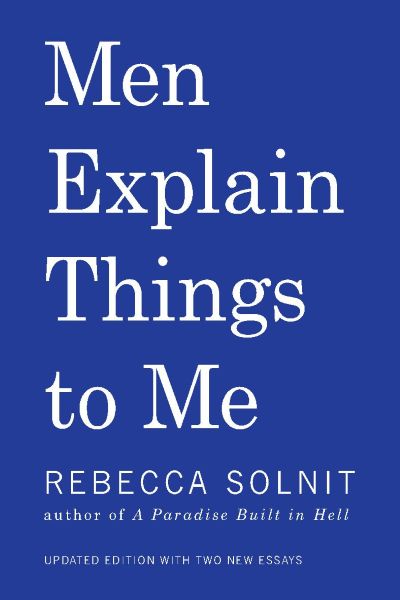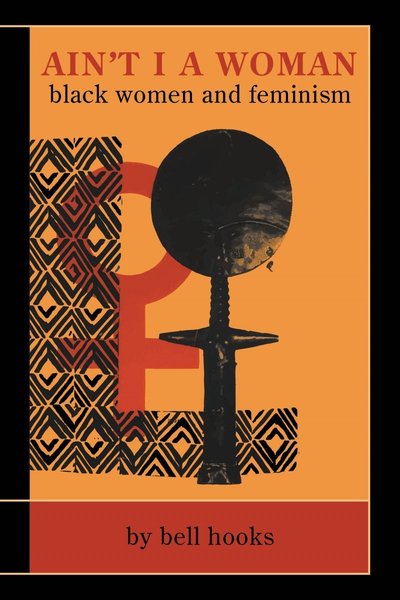Men Explain Things to Me
A modern feminist classic that deeply explores the phenomenon of 'mansplaining' and its impact on women. Solnit's sharp writing reveals gender power relations in everyday life, providing important perspectives for understanding contemporary women's circumstances.

📝 Book Review
In the brilliant constellation of contemporary feminist discourse, Rebecca Solnit’s Men Explain Things to Me shines like a bright morning star, illuminating the most subtle yet pervasive phenomena in gender power relations with its sharp and elegant prose. This 2014 work not only deeply explores the daily manifestations of power in “mansplaining” but has become an important theoretical text for understanding contemporary women’s circumstances, its influence extending far beyond academic circles to permeate every corner of social and cultural discussion.
Born in 1961, Solnit’s writing career serves as a bridge connecting academia with the public, transforming profound theoretical insights into cultural criticism that everyone can understand. As a prolific author, she has written over twenty books, with creative fields spanning political commentary, environmental protection, art criticism, and more, demonstrating an admirable breadth of knowledge. She has long contributed to authoritative media outlets such as Harper’s Magazine and the London Review of Books, winning a broad readership with her keen observations and beautiful prose. More importantly, Solnit has never been merely an ivory tower scholar; she actively participates in various social justice movements, closely combining theoretical reflection with practical action, embodying the social responsibility of an intellectual.
The birth of the “mansplaining” concept stems from Solnit’s personal experience at a gathering. At the time, a male guest pompously explained to her about an “important book,” completely unaware that this book was actually Solnit’s own work. This seemingly absurd scene revealed a profound and universal social phenomenon: men often automatically assume they are more authoritative on any topic than women, even in fields where women are clearly more professional. The core of this phenomenon lies in a deeply ingrained assumption of authority—men unconsciously believe they naturally possess the power to explain and teach, while women are assumed to be objects needing enlightenment.
Behind this display of power lies a complex mechanism of discursive hegemony. When men appear in an “explanatory” posture, they are actually denying women’s rights to express their viewpoints and professional knowledge. Women’s voices are silenced, their professional experiences questioned, their lived experiences negated by men’s “theoretical knowledge.” This is not merely impolite behavior at the personal level but a systematic way of operating power that maintains and reinforces existing gender hierarchies through daily micro-interactions. Solnit keenly perceives that this phenomenon reflects men’s monopolistic attempts in the field of knowledge production and dissemination, as they assume natural speaking rights and interpretive authority on all topics.
This collection consists of seven interconnected essays, each serving as a mirror reflecting the complex dimensions of gender power relations from different angles. The opening titular essay “Men Explain Things to Me” sets the tone for the entire book, starting from that tragicomic gathering experience and gradually revealing the power mechanisms hidden in daily interactions. “The Longest War” expands the scope to broader violence analysis, exploring how systematic violence against women serves as a tool for maintaining patriarchal dominance. In “Worlds Collide in a Luxury Suite,” she deeply analyzes the absence of women’s discursive power, revealing the power struggle between silence and speech.
The chapter “In Praise of the Threat” deserves particular attention, where Solnit discusses the various threats women face daily, from explicit violent threats to implicit psychological suppression, constituting a complete spectrum of threats. “Virginia Woolf’s Angel” shifts focus to the literary creation field, exploring how female writers seek their own voices within male-dominated literary traditions. “Cassandra Among the Creeps” cleverly borrows the prophet figure from Greek mythology to analyze the distrust and marginalization women often encounter when warning of social problems. The final “#YesAllWomen” extends the discussion to the social media age, exploring new forms and challenges of feminist discourse in digital spaces.
In these essays, Solnit constructs a unique analytical framework that elevates seemingly trivial daily interactions to the level of political analysis. She acutely realizes that gender power relations exist not only at the macro-institutional level but are deeply rooted in daily micro-interactions. Through detailed analysis of language usage patterns, she reveals how discourse becomes an important tool for constructing and maintaining gender inequality. At the same time, her cultural criticism perspective shows us how cultural representations play crucial roles in shaping people’s gender perceptions. More importantly, Solnit always places contemporary phenomena within historical contexts for understanding, helping us recognize the profound connections between today’s gender issues and historical traditions.
Solnit’s contributions to feminist theory are multi-layered, with the most significant being her successful terminologization of countless women’s shared experiences, creating the precise and powerful concept of “mansplaining.” The significance of this terminologization extends far beyond providing a label; it grants public and political character to previously scattered, privatized experiences, enabling women to name their encounters and thus form collective recognition and action. Through this conceptual innovation, Solnit opened new fields in micropolitics, shifting research focus from grand institutional analysis to subtle but important power relations in daily interactions. She showed us that power exists not only in congress halls and corporate boardrooms but also permeates every daily conversation and every explanatory gesture.
In discourse rights theory, Solnit’s contributions are equally profound. She deepened our understanding of the gendered nature of free speech, revealing how seemingly neutral “free expression” is actually distributed in gendered ways. Men’s voices are assumed to be authoritative and rational, while women’s voices are often questioned, marginalized, and explained away. More importantly, she established an analytical framework spanning from mansplaining to violence, showing how seemingly harmless “explanatory” behavior logically connects with more serious forms of gender violence. This continuum perspective helps us recognize that gender oppression is not composed of isolated events but is a systematically interconnected structure.
In research methodology, Solnit demonstrates impressive innovative spirit. She takes personal experience as the starting point for theoretical construction but never stops at personalized narrative, instead elevating individual experience to social analysis with universal significance. This methodological innovation lies in her successful balance between the personal and political, making theory both flesh and blood while possessing critical sharpness. At the same time, she skillfully integrates research methods from literature, history, sociology, and other disciplines, demonstrating the powerful explanatory force of interdisciplinary thinking. Her ability to read gender meanings from cultural products is particularly outstanding—whether literary works or popular cultural phenomena, she can keenly analyze their embedded gender political content. Finally, her writing style combining academic reflection with current affairs commentary provides an important model for the social participation of knowledge production.
The speed and scope of social dissemination of the “mansplaining” concept is rare in modern academic history. This term quickly moved from academic papers to mainstream media, with major outlets from The New York Times to the BBC beginning to use this terminology to analyze and report related phenomena. Even more impressive is how quickly it entered the vocabulary of daily conversation and online discussion, becoming a common tool for people analyzing and discussing gender relations. On social media platforms like Twitter and Facebook, the #mansplaining hashtag has gathered countless women sharing similar experiences, forming a vast network of experience sharing.
This conceptual popularization extends beyond the linguistic level to deeply influence policy-making discussions. In workplace and educational fields, the “mansplaining” concept provides theoretical tools for formulating more gender-sensitive policies. Human resources departments began incorporating related content in training, and educational institutions started reflecting on gender dynamics in classroom interactions. More importantly, this concept crossed linguistic and cultural boundaries, being translated into French “mecsplication,” German “Mansplaining,” and many other languages, sparking widespread global discussions about gendered communication patterns.
This broad social influence has catalyzed deep cultural reflection and reform. In workplace culture, more and more organizations began recognizing the importance of improving meeting culture and promoting women’s participation, advancing gender equality reforms in work environments. The education field also began reexamining gender patterns in teacher-student interactions and peer exchanges, exploring how to create more inclusive learning environments. The media industry’s sensitivity to gender issues has continuously improved, with journalists and editors paying more attention to avoiding gender bias in reporting and increasingly adopting women experts’ perspectives. Most interestingly, this concept has promoted intergenerational dialogue about gender issues—older women discovered that their years of experiences finally had specific terminology, while younger women gained help in more clearly identifying and addressing similar situations through this concept.
However, like any influential theoretical concept, “mansplaining” has generated widespread controversy and discussion. Academic attitudes toward this concept are not entirely consistent, with some scholars questioning whether this might lead to oversensitization of gender interactions, worrying it might hinder normal academic exchange and knowledge sharing. Discussions about conceptual boundaries and application conditions are also intense, with how to distinguish well-intentioned explanation from gender-biased “mansplaining” becoming a complex judgment issue. More interestingly, this concept has triggered defensive reactions from some men, with some worrying their normal explanatory behavior might be misunderstood—this reaction itself has become important material for gender studies.
Constructive criticism from within feminism is equally worthy of attention. Some scholars point out that Solnit’s analysis is primarily based on white middle-class women’s experiences, potentially overlooking the more complex situations faced by women of color. Discussions about conceptual applicability across different cultural contexts are also important, as “mansplaining” may manifest in different forms and characteristics across cultures. Generational differences are also factors that need consideration, as women of different ages may have varying perceptions and reactions to this phenomenon. Finally, some critics note that while Solnit successfully diagnosed the problem, there’s room for improvement in providing specific strategies for change.
Solnit’s writing charm lies in her successful perfect combination of academic rigor with readability, creating a unique style of essay-like cultural criticism. Her writing possesses both theoretical depth and beautiful literary quality, making complex gender theory accessible. She excels at using personal experience as a starting point for theory construction but never limits herself to personalized narrative, instead elevating individual experience to social analysis with universal significance. Particularly commendable is her maintenance of appropriate humor within sharp criticism, a style that makes her writing both powerful and warm.
In narrative strategy, Solnit demonstrates superb skill. She always uses concrete, vivid cases to illustrate abstract concepts, making theory tangible and touchable. She excels at placing contemporary problems in historical contexts for comparative analysis, showing us continuities and differences between present and past. She is widely read, extensively quoting literature and art works in her articles, demonstrating deep cultural literacy. Most importantly, she possesses the ability to express complex theories in everyday language, enabling ordinary readers to understand and accept profound academic viewpoints.
Solnit’s Men Explain Things to Me occupies a unique position in the genealogy of feminist theory, both inheriting the spiritual core of classical feminist theory and pioneering new theoretical territories under new historical conditions. Her work can be seen as a contemporary development of Simone de Beauvoir’s existentialist feminist tradition, particularly in analyzing how women are constructed as “the Other.” If de Beauvoir revealed women’s passive position at the existential level, then Solnit further revealed how this position is maintained and reinforced in daily knowledge exchange.
Her analysis also forms interesting echoes with Betty Friedan’s The Feminine Mystique. Friedan focused on women’s “nameless problem” in the domestic sphere, while Solnit extended this analysis to the discursive realm, revealing the “nameless oppression” women face in knowledge production and dissemination. At the same time, her work engages in profound dialogue with Judith Butler’s theory about the performativity of gender discourse rights, both focusing on the role of language and discourse in constructing gender relations. Audre Lorde’s emphasis on the importance of marginal voices finds new interpretation in Solnit’s analysis of women’s lack of discursive power.
In the contemporary feminist dialogue network, Solnit’s voice forms productive interactions with many important writers. She shares similar concerns with Sheryl Sandberg in the micro-analysis of workplace gender discrimination, both committed to revealing seemingly subtle but actually far-reaching power mechanisms. Her dialogue with Roxane Gay about “imperfect feminism” forms echoes, both emphasizing that feminism should be more inclusive and realistic. Her consensus with Chimamanda Ngozi Adichie on the daily practice of feminism reflects contemporary feminist theory’s practical turn. Her exploration with Margaret Atwood in combining literature with feminist criticism demonstrates the rich possibilities of interdisciplinary research.
In the digital age, Solnit’s theory shows remarkable prescience and continued relevance. Her analysis of discursive power provides important tools for understanding gender dynamics in cyberspace, promoting widespread discussions about online gender equality. The “mansplaining” concept provided important theoretical foundation for social movements like #MeToo, helping people understand the continuum characteristics of gender violence. Social media platforms also referenced her theoretical framework when formulating related policies, striving to create more gender-friendly digital environments. More importantly, her work raised awareness of online gender discrimination, promoting the development of digital literacy education.
In education, this work has become an indispensable important text in gender studies courses, providing rich materials and analytical frameworks for classroom discussion. It has direct guiding significance for improving gender relations in educational environments, helping teachers and students identify and address gender bias in classroom interactions. By cultivating students’ gender sensitivity, this work makes important contributions to critical thinking education. Finally, it successfully connects literature, sociology, psychology, and other disciplines, providing excellent examples for interdisciplinary teaching.
The global dissemination trajectory of this work is itself a fascinating cultural phenomenon. Starting from the United States, the “mansplaining” concept quickly crossed borders, being translated into dozens of languages and spreading worldwide. In different cultural soils, this concept presents interesting adaptive changes, with each culture developing localized understanding and interpretation based on its own characteristics. This global dissemination not only promoted cross-cultural feminist dialogue but also inspired feminist practitioners everywhere to combine local conditions in their work.
In China, this work generated particularly enthusiastic responses. On Chinese social media platforms like Weibo and Douban, discussions related to “straight male cancer” formed interesting dialogues with the “mansplaining” concept. Chinese scholars also actively participated in related research, combining Chinese cultural traditions and social realities to analyze gendered communication patterns with Chinese characteristics. Some researchers connected ancient “male superiority, female inferiority” thought with modern “mansplaining” phenomena, exploring the continuation and changes of traditional culture in contemporary gender relations. This localized theoretical development provided important theoretical support for women’s rights protection work in China.
Over time, the “mansplaining” concept continues to develop and improve. Researchers began conducting more detailed classifications of this phenomenon, identifying different types of mansplaining behaviors and their characteristics. Meanwhile, more practical research focuses on how to respond to such situations, providing women with specific strategies and techniques. At the institutional level, this concept promoted related policy reforms, from corporate training to educational curricula, all beginning to incorporate content related to gendered communication. More broadly, it promoted transformation in overall social cultural attitudes, encouraging more people to reflect on and change their communication methods.
From the perspective of academic legacy, Solnit’s work has opened multiple new directions for subsequent research. It promoted in-depth research in microsociology on gender analysis in daily interactions, making scholars focus on seemingly insignificant but actually far-reaching power mechanisms. In discourse analysis, it provided important examples for in-depth research on gendered discourse. As a model combining theory with practice, it also made important contributions to the development of applied feminism. In cultural studies, it provided effective methods for interpreting gender meanings from cultural texts.
Today, Men Explain Things to Me continues to shine in the sky of 21st-century feminist theory with its unique insights and lasting influence. It not only provides us with precise tools for understanding daily gender power relations but also offers solid theoretical foundations and clear action guidelines for promoting specific practices of gender equality. This book’s influence has long transcended academic boundaries, becoming an important force for changing social cultural attitudes, continuing to inspire readers worldwide to think and act, contributing its own strength to building a more equal and just society.
Discussion
读书讨论
分享您对这本书的感想和看法,与其他读者交流见解
加入讨论
分享您对这本书的感想和看法,与其他读者交流见解
加载评论中...
Book Info
Related Topics
🛒 Get This Book
 Buy on Amazon
Buy on Amazon Related Books
读书讨论
分享您对这本书的感想和看法,与其他读者交流见解
加入讨论
分享您对这本书的感想和看法,与其他读者交流见解
加载评论中...

